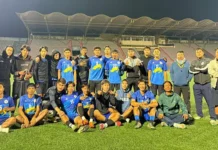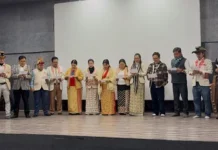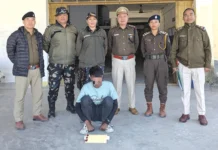TEZU, 17 Apr: Lohit DC KN Damo emphasised the importance of greater collaboration between the Health Department and other key sectors such as Education, ICDS, and Women & Child Development.
Chairing a meeting of the District Health Society and the District Task Force for Immunisation here on Thursday, the DC also called for stronger cooperation with defence organisations present in the district.
Highlighting the crucial role of community health workers, the DC advocated enhanced motivation and support to ASHAs and anganwadi workers, particularly in improving key child and infant health indicators through the home-based young child care and the home-based newborn care programmes.
NHM-RCH District Programme Manager Nani Lampung presented a comprehensive overview of the immunisation status for FY 2024-25, and outlined the micro-plan for routine immunisation for FY 2025-26. He also highlighted the achievements under the RMNCH+A initiatives.
District Surveillance Officer Dr S Towang shared insights into the district’s progress under the non-communicable disease programmes. He reported a steady decline in malaria incidence over the last decade, showcasing the effectiveness of ongoing public health interventions.
The meeting also witnessed the participation of DMO Dr CL Manchay, the DUDA executive engineer, the DDSE, the ICDS deputy director, district programme officers of various NHM verticals, the medical superintendent of the zonal general hospital here, medical officers, representatives from the BRO and the ITBP, and others.
Tourism development meeting
The DC also chaired a meeting focused on the development of tourism in Lohit district on Thursday, and emphasised that Lohit’s tourism growth must be community-driven, inclusive, and sustainable.
The meeting, organised by District Tourism Officer Dibroo Catherine, saw the participation of tourism stakeholders across the district, including homestay owners, hoteliers, resort operators, and tour operators.
The DC underscored the vast potential of tourism in Lohit district, and urged the stakeholders to proactively develop unique tourism experiences, drawing inspiration from models like Tawang, “which is currently experiencing full tourist occupancy.”
Promotion of vegetable gardens, offering wildlife and nature experiences, video documentation of successful homestay stories, etc, were discussed during the meeting.
The stakeholders suggested empowering local tour guides through structured training and integration into tourism activities; conservation of biodiversity, including local wildlife, flora, and fauna as integral part of ecotourism; promoting cultural tourism, etc.
The stakeholders also noted the potential to thoughtfully integrate spiritual and heritage-based experiences into the district’s tourism offering.
The meeting concluded with a unified vision to transform Lohit into a vibrant, culturally rich, and environmentally responsible tourism destination, with the local community at its core. (DIPRO)





